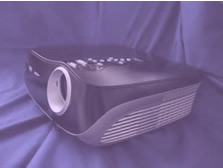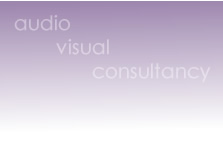|
DVI/HDMI - What you need to know!
Video displays are going digital. We all knew that I suppose but whereas LP to CD was a relatively straightforward task
for dealers and consumers the change from analogue displays and sources to digital ones is not. This article is going
to try to help prepare you for the sorts of problems you need to be aware might arise.
It's probably not escaped most folks attention that new DVD players are starting to come out with Digital Video outputs.
Most common right now are DVI sockets. Less common but more likely to become prolific are HDMI sockets. What are they
and can you use them to benefit your customers?
Well, DVI is a transmission method developed to go from PC's to monitors. As it is all digital there was no requirement
for expensive analogue circuitry in the PC or flat panel monitor, meaning they could be made for less and marketed as
having added value ie sold for more... clever. Amongst other things, the design never took in to account the need to
possibly have the monitor any distance from the PC itself. This digital signal interface therefore can have issues with
image quality and operation over distances above 4m. Newer DVI transmission and reception devices are better than early
generations and can send and receive over further distances. I would suggest though that if you are trying to go over
4m you always do a compatibility test before burying cables in the walls!
As DVI was initially designed for computer systems not domestic video systems it has created some other problems. The
first of these is that they needed to add copy-protection to this output signal to appease the software providers. To
this end DVD players with DVI outputs will generally (but not always) have a thing called HDCP enabled on them. This is
the digital equivalent of Macrovision. Basically, if the DVD software is flagged as being copy-protected then
Macrovision is added to analogue outputs and HDCP is added to the digital DVI output. DVI which carries HDCP is
only able to be viewed back on display devices that have HDCP capabilities as well.
There's more. The technical specs for black and white levels on PC DVI signals and VIDEO DVI signals are different.
This can result in level mismatches and poor picture quality. Some display devices might be expecting VIDEO level DVI
in but are getting PC Levels, or vice-versa. Ideally you need to be aware what your source sticks out and what your
caler or display is expecting.I expect that new devices, particularly video processors, will be able to accept these
varying signals and transcode them to the levels appropriate for the chosen display device, certainly the new Lumagens
will.
Many displays that have DVI inputs are also set up for gamma tracking and greyscale more suited to PC presentation
playback than video. This can lead to poor quality images too.
As it was a PC to Display interface it also supports a thing called EDID. EDID is basically a plug and play protocol
that allows the display to tell the source what resolution it is forcing the source to set it's output resolution to
the correct one for the display. Sort of a cool feature if it worked. Unfortunately not all EDID's are set correctly
and you may find that the resolution that is ideal for a display is forbidden by the EDID. Again, you need to test all
compatibility first.
The DVI socket is just a port of sorts, just like a VGA socket is for analogue. You can send all sorts of resolutions and
refresh rates down a DVI cable and through the port. In fact you can even send analogue signals out of it too! However,
the presence of the DVI socket on a display does not mean that it will be able to display the resolution or refresh rate
you are sending it. This is very important. It's not plug and play. See above...
HDMI: This is the next step in consumer electronics connectivity. HDMI is a smaller connection that carries essentially
DVI picture protocols with HDCP and also multi-channel high resolution audio. It's commonly touted as the SCART for this
generation. It is supposed to be plug and play. HDMI was designed with the benefit of seeing the faults with DVI and SPDIF
(audio). As such the transmitter and receiver IC's are capable of sending data over greater distances. Plug two HDMI
sources and displays together and you should get a picture.
As DVI HDCP is a subset of HDMI it also means that you can get a breakout cable to take the HDMI video output part and
feed it to a DVIHDCP compatible display or vice-versa. Well, that's the theory. The same holds true though that just
because they could talk to each other and display an image it doesn't mean to say they will. Always do a physical check
for compatibility (never rely on specifications alone).
HDMI specs allow 480i and 576i digital outputs which DVI specs do not. DVI requires at least a 480P bandwidth signal to
be output. What does that mean? Well it means that if you are using DVI out (with or without HDCP it doesn't matter)
then you will likely be sending a signal that is already de-interlaced to 480P/576P or perhaps scaled higher even.
You will be limited in performance by the de-interlacing and scaling of the source devices electronics. If you could
send the 480i or 576i information out to a suitably equipped external video processor the chances are you could get
better results. Having said that, just because 480i and 576i are within the HDMI specs it doesn't mean that a source
with HDMI out will actually have those output resolutions enabled on the product. In fact I have been trying to find an
HDMI DVD player to try this with and the cheaper of the current HDMI Pioneers doesn't allow these resolutions. The
forthcoming Immersive DVD player will.
Firewire: We wont worry about firewire just now. Firewire sends an MPEG data stream at present. This means that
the display device must have an MPEG decoder built in to it to decode this data and produce an image. This
would mean adding MPEG decoders to TV's, plasma's, projectors, monitors. We already know that most manufacturers
try to reduce costs (DVI...) so I am not sure that this is going to become an issue for any of us soon.
SDI: Serial Digital interface is a broadcast standard. It is not commonly available on DVD players or SetTopBoxes as an
SDI signal carries no form of copy protection. There are many companies who can add aftermarket mods to these sources to
add this output though. Not all devices can have an SDI output added due to the variance in design of MPEG decoders used
in them. For instance the TAG DVD32r cannot be modded but an Arcam DV88+ can. This digital video output offers the best
picture quality transmission method possible from SD sources
Jim Peterson of Lumagen commented, "SDI is 4:2:2 YCbCr, which is exactly what comes out of the MPEG 2 decoder. DVI is
4:4:4 RGB, and leaves lots of room for the DVD vendors to screw it up and in fact adds two color space conversions to
our video path, which can only hurt."
So to summerise:
| (From) SOURCE |
(To) DISPLAY |
RESULT |
| DVI |
DVI |
Might get a picture |
| DVI |
DVIhdcp |
Might get a picture |
| DVIhdcp |
DVIhdcp |
Might get a picture |
| DVI |
HDMI |
Might get a picture |
| DVIhdcp |
HDMI |
Might get a picture |
| HDMI |
DVIhdcp |
Might get a picture |
| HDMI |
HDMI |
Might get a picture |
| HDMI |
DVI |
No pic with protected software |
| DVIhdcp |
DVI |
No pic with protected software |
In all cases video levels and transmission distances should be checked before installation or specification. Remember
even if you do get an image it might be worse than using an analogue signal route!
We are in a state of transition just now. Most customers have multiple interlaced and progressive analogue sources.
They will be adding digital sources and displays to their systems over the next few years. Devices that can accept
these diverse signal types and resolutions, switch them, process them to increase image quality and then output them
in an ideal form for their display device are going to be very sought after. Convergent will bring you these products
and we'll continue to help you understand how to get the best out of them for your clients.
If you have questions about any of this or about general video please feel free to email us at
helpme@convergent-av.co.uk
(Click here to go back to Articles archive)
Copyright ©2003-2011 Convergent-AV. Not For Re-Publication.
|



